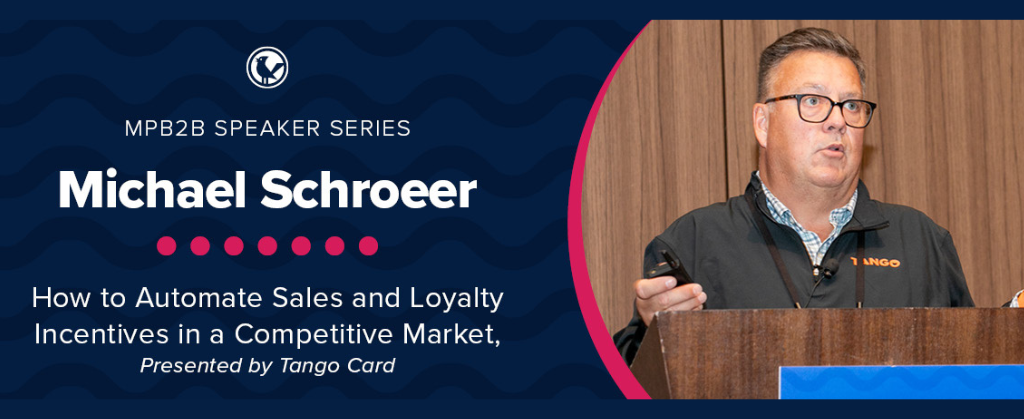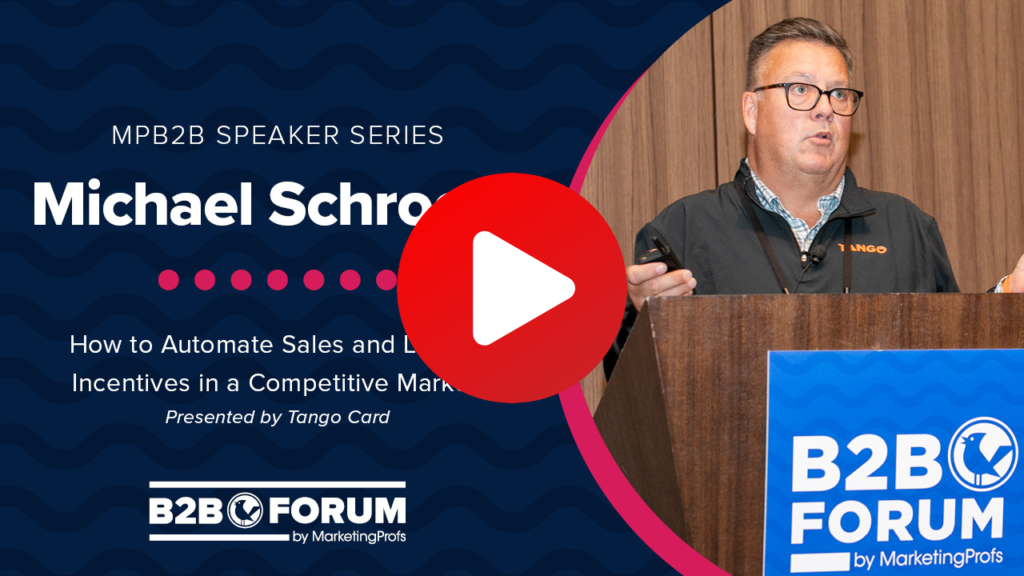
Discounts, lead magnets, bonuses, rebates, and more—marketers use incentives to attract buyers and qualified leads all the time.
But how often do we ask ourselves if our efforts are fiscally responsible?
Are you targeting the right people with your marketing?
In this clip from B2B Forum, Michael Schroeer, marketing product manager at Tango Card, shares his insights on fiscally responsible incentive marketing.
Watch the video clip or read the transcript below.

Most of you probably already know this. But sometimes it’s good to get grounded back to the basics.
So, what is incentive marketing?
Really, marketers set up long-term programs and limited time promotions that use small gifts, payments, rebates, or discounts to encourage prospects to take action.

Essentially, what you’re trying to do is help motivate or help change behavior or encourage certain types of behavior.
It is all about behavior.
Loyalty programs really are about, “how do you take and grow and retain your existing client base,” which can be just as important as acquiring new clients, especially as you’re looking at SQLs.
That’s great. We drive all kinds of SQLs. But money in the bank counts for a lot too. So don’t forget about those types of programs also. We’ll talk through a couple of different types.
Big question: “should I implement incentive marketing?”
Well, the short answer is yes!

First question is why they work. There is more proof out there. And it just keeps coming back in. And I think common sense tells us that if we take and put an incentive out in front of an individual, they’re more than likely going to do it.
It’s going to give you brand awareness, if done right. Your programs have to be structured right to make these work, but it’s going to give you that exposure that’s needed.
It’s going to help you stand out in a competitive landscape, meaning you are going to look different, potentially, than your competitor. It gives you something a little different that you’re talking to the client.
It helps move prospects through the funnel to get them to come and do a demo, get them to pick up the phone and make a call so that you’re now talking to them rather than just assuming their senior, your advertising or your messaging or your blog or whatever it is. Get them to do something as well.
Make prospects feel appreciated. Start the conversation with them. You’re giving them something, and you’re not expecting them to give at this point. It sort of neutralizes the ground.
A lot of people are concerned, “oh, I’m going to do an incentive and people are just going to blow me off.” Well, sure. That happens.
But I’ll tell you, in most cases, most people are honest enough that, “hey, if I’m given something, I’m going to at least take a couple minutes.”
And that couple minutes may be the difference between a new lead and not having that lead.
So if we look at creating a successful program—and this can be incentive or loyalty—and call this the CliffNotes version.

You’ve got multiple ways that you can set these programs up. But think of this as if you hit these and you hit these, well, your program will be successful.
And the first part is: define your objective goal and the success metrics that are going to go along with that.
I’ll share a little story. It was actually really timely. I had an offer, it came in my email, for a $50 Uber Eats for a 15 minute conversation to hear about this software.
And frankly, as I’m looking, I’m not quite sure where they got my name from or if they looked at my title, but the software they were offering didn’t necessarily fit and it was for 15 minutes. So $50 for 15 minutes, and it was for a “virtual lunch,” which was great. And all I had to do was go on and set up on Calendy.
So of course, being the marketing guy and product marketing, I’m like, “let me see how these guys do this.” I went through the process. And what was really interesting is, it was very apparent.
Nobody really sat back and looked at an overall goal. “What are we actually trying to accomplish with this incentive?”
Because incentives are more than just putting something out and saying, “hey, here’s something nice.” Whatever. We, ultimately, in our companies, fiscally responsible, we want something in return for that. And not necessarily directly from that individual, but it’s got to be sort of scoped out.
And so in this case, I’m looking at it, and the goal was to get me into a 15 minute conversation. Well, what does that actually result in? I’m not sure. I’m going to have the meeting sometime next week. It’ll be interesting.
However, what I will tell you is, I don’t feel like they probably defined their goal really well because they didn’t hit the right person!
I don’t know that, from a fiscal responsibility [perspective], it looks like their goal really was to get as many people to talk to sales reps as possible.
And that’s not necessarily a bad goal. That can work—try not to spend $50 for it—but you have to really map out, “what do you want to take and do?”
Really, spell that goal out.
Published 11/29/23
B2B Forum is packed with marketing insights, strategies, and tactics taken from the real world experience of over forty industry experts, packaged into context you can actually put to use.
Join us in Boston for B2B Forum 2024 this coming November 12-14, 2024. Early buyers get B2B Forum tickets at their lowest rate, and discounted hotel rooms are available while they last.